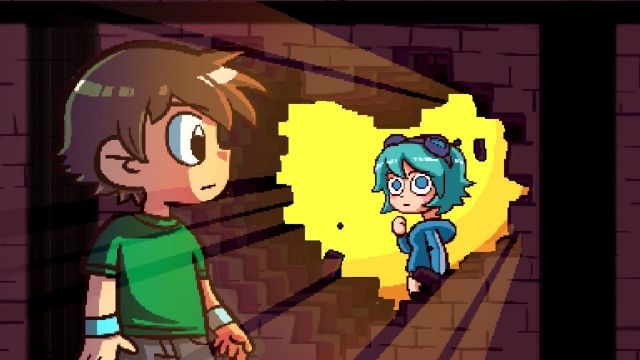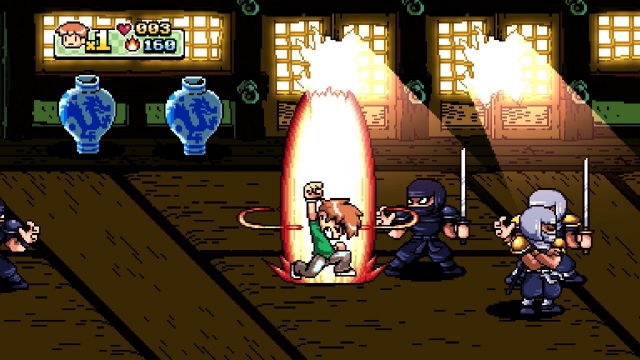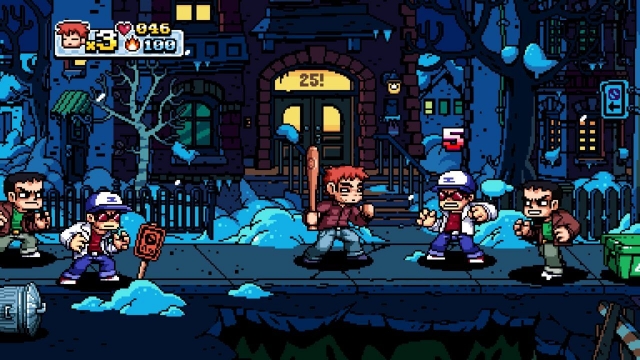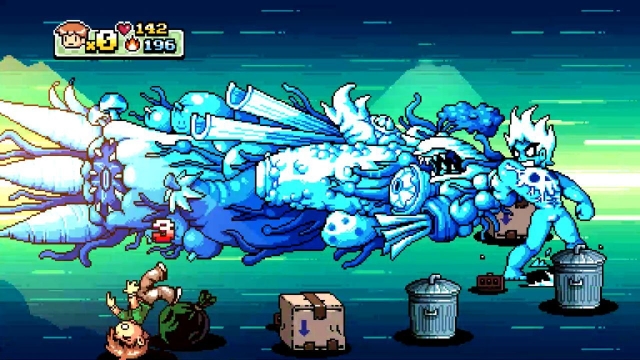Scott Pilgrim vs. The World: The Game – Complete Edition
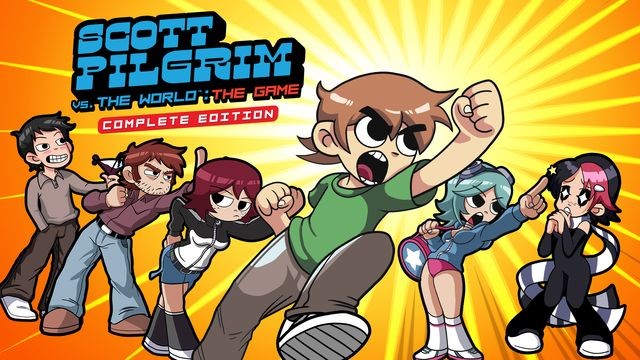
The original release of Scott Pilgrim vs. The World: The Game was something that transcended the franchise in both comic book and movie form, and became something all its own. Normally, licensed games have a fairly narrow appeal when they’re based on an existing media property and they’re targeting fans of that property alone. With this game, Ubisoft set out to please gamers and craft something that could work as a gateway game for the franchise if you hadn’t seen anything else from it. The comic books were somewhat niche and beloved and the major motion picture was well-regarded, but wasn’t seen as this end-all/be-all creation either. In developing the game, the basic framework of Scott trying to defeat his wannabe-girlfriend Ramona’s exes was maintained – while the execution was altogether different from either prior medium. The game took advantage of its platform to tell the story in a different way and worked for both franchise veterans and newcomers alike.
Scott Pilgrim vs. The World: The Game is a beat ‘em up and one of the best ever in the genre. It’s influenced the most in its format and overall game feel by the Kunio-Kun/River City Ransom games and could easily be mistaken as a ROM hack had one existed for a 32-bit entry in the series. Scott battles tons of foes throughout the city of Toronto and just like the River City Ransom games, you can boost your stats by buying items and become more powerful by purchasing move upgrades. Since the story itself is also about Scott bettering himself, you also have an in-canon reason for things like XP boosts, being that he’s gaining more skills and confidence as time goes on. The “evil exes” themselves are a tremendous group of characters from a visual standpoint and really work out nicely when it comes to having each stage they’re in look and truly feel different.
Things start off serene enough as you go through the streets of Toronto and beat folks up around a neighborhood – all the while tackling bullies, dogs, and even engaging in a snowball fight. It’s clear early on that this isn’t your average brawler. When you get into a groove after stunning an opponent, you can lay them out with massive combos – which can rack up into the hundreds if you’re able to go from enemy to enemy to enemy. Those moments are rare, but they’re ton of fun and allow you to get a thrill that you really don’t get from other games. Even now, you don’t see games allowing you to beat THAT much crap out of your enemies. Mid-air juggles are also a blast and you have a wide variety of attacks to use to initiate them and keep them going.
Starting a melee with a running heavy attack and then keeping it going with light attacks is the easiest way to do it. You also have the chance to go from a mid-air juggle to beating up your surrounding rivals and if you get surrounded, you have a right bumper attack to use to take out a few people at once. Taking out enemies is pretty satisfying, especially since they drop cash and when the screen is cleared out, you have a chance to soak in the atmosphere and explore the world a bit with some backtracking. It’s fun to take out enemies and then go shopping and see what you can get. The shopping district in particular is a great place to kill some time since you can take out a bunch of enemies and then farm them for money to earn a bunch of health, XP boosts, move upgrades, or a combination of them.
It’s incredible satisfying to feel your chosen character get stronger – but there is definitely a bit too much grinding required to make steady progress through the game. In theory, you should be able to do a straight run from stage to stage without the game crushing you completely. The problem is that early-on, you’re quite underpowered and it takes a good hour or so of grinding to get your stats up to where you can absorb a solid amount of damage. It may seem like a “get good” situation, but you can leave a shop and then get smacked around by a single combo for a loss of 25 HP pretty easily, and that’s not counting spike traps and other hazards later on that are designed to eat your virtual quarters up. The game’s multi-tiered stages have checkpoints in the sense that if you die and have a continue, you merely resume with partial health unless you have a health pick-up – but a game over sends you back to the main overworld map no matter how far along in the stage you are.
This means that if you run out of lives right at the final boss battle in that area, then you’re SOL and have to replay the stage. You may also have to play another stage before that after getting kicked back in case the stage doesn’t have any shops. Shops are the only places you can go to get health pickups that can help your HP while also allowing you to store a snack for use if you fall in battle to revive a bit of your health. It sucks to get into a groove, hit a brick wall with a boss and then have to retrace your steps and hope to win. The best thing to do if you’re going into a new level with under three lives and without health pickups is to just do as well as you can. If you’re lucky, you’ll level up and that will replenish your health.
Dying also isn’t the worst option if you just treat a stage with two lives as a test to learn patterns and figure out its basic layout. Doing that ensures that you’ll learn things like where the worst hazards are, shop locations, and who knows, you may just get lucky and win if everything shakes out. The game’s stages do have some jank to them though – like a mid-game section where you run up a fire escape while avoiding enemies…in theory. In execution, you really can’t avoid them and thus you’ll wind up getting thrown into the abyss and losing health and possibly lives if you aren’t careful. This is all a pre-amble to a sub-boss battle and that in and of itself is a prelude to a platforming section full of massive damage traps and knockback-causing bats – so it’s all a fairly frustrating endeavor when you prepare to battle the legally distinct from Double Dragon Twin Dragons. However, tackling this section with some knowledge of what’s going to happen does help mitigate the frustration.
It’s a shame that some of these loose screws weren’t tightened up because they would make for a more fun and cohesive experience. Thankfully, the Complete Edition features all of the original game’s DLC content – including new characters to level up and play as, alongside the ability to do a New Game+ with all of your stat boosts and any new weapons. You can also engage in some dodge ball – furthering the Kunio-Kun connection – partake in a battle royal mode years before that was an in-thing, or enjoy a horror-themed mode that acts as a survival mode of sorts that tests your skills. There’s a lot to enjoy here, including car-breaking mini-games to help keep you on your toes at all times.
Visually, Scott Pilgrim vs. The World: The Game has aged perfectly – and it helps that they were going for a mix of a 16-bit and 32-bit art style a decade ago. There haven’t been a ton of 32-bit-style games when it comes to character art and sprite detail, and this edition looks as good now as it did then – and maybe even a bit better thanks to the bump up in fidelity provided by newer hardware. Everything looks a bit sharper visually, with more details visible. One thing that stuck out playing through the game a decade later is that things that were at least still somewhat relevant a decade ago – like CDs and DVDs – being referenced in the in-game world add to this feeling a bit like a time capsule. It’s a fun juxtaposition since it’s a time capsule of the late-’00s, while also being a throwback to the beat ‘em up genre – which had an early ’90s peak – and while also using a sprite art style that would be at home in the late ’90s. It’s a strange formula in some ways, but it works wonderfully in execution.
The game’s soundtrack was an all-time great a decade ago and remains so to this day. Even with more chiptune soundtracks out there, nothing outside of Shovel Knight has really come close to matching it. It’s one of the fastest-paced chiptune OSTs and gets your blood pumping for every battle. The sound effects for attacks are also good, and each weapon feels satisfying to use. The sound effects also play a nice role in helping time out juggles – whether you’re juggling an enemy or sending a basketball to the edge to the screen and back to take out an enemy with the bounce physics. It’s a great-looking and sounding game and one of the best retro-inspired experiences a player can ask for.
Scott Pilgrim vs. The World: The Game – Complete Edition is a must-buy for any fans of beat ‘em ups who missed it the first time around. With the game hitting all consoles and PC via the Epic Games Store, it is now going to be archived for a much longer period of time and its reach won’t be as limited as it was before. The gameplay is satisfying and it remains one of the best brawlers ever – with a top-tier combo system and soundtrack that is as fun to listen to now as it was a decade ago. The included DLC from the original game’s release adds extra value as well, and gives the game an even longer shelf life.
Reviewed By: Jeremy Peeples
Publisher: Ubisoft
Rating: 90%
——————————————————————————–
This review is based on a digital copy of Scott Pilgrim vs. The World: The Game – Complete Edition for the PlayStation 4 provided by Ubisoft.
 Game Over Online
Game Over Online